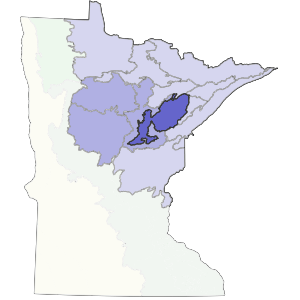The boundaries of this subsection coincide with the boundaries of the Glacial Lake Upham Plain and the Aurora Till Plain. This is a unique area topographically and climatically. The till plain is included because it forms a relatively flat plain ecologically similar to the adjacent lacustrine plain.Level to gently rolling topography are characteristic of this region. The largest landform is a lake plain. Around the edges of the old glacial lake is a till plain (Aurora Till Plain) formed in Superior lobe sediments. There is also a small piece of end moraine north of Sandy Lake that is related to the St. Louis moraines. Lowland hardwoods and conifers were the most common forest communities. Northern hardwood and aspen-birch forests were common on the other portions of this region. Presently, much of the land is in public ownership. Forestry and tourism, along with some agriculture are the most common land uses.
Landform
Glacial lacustrine (lake deposited) sediments occupy much of the subsection. Beach ridges are not well defined. The lake was probably not present at one level long enough to form distinct beach ridges (as are found in the Glacial Lake Agassiz basin, to the west). There is a ground moraine along the northern and southern borders of the Glacial Lake Upham basin. Low drumlin ridges. are present locally.


